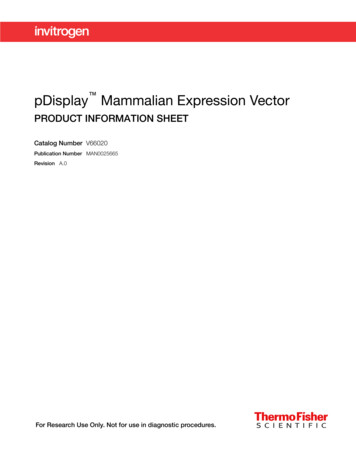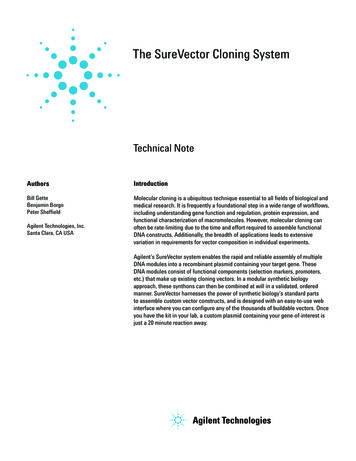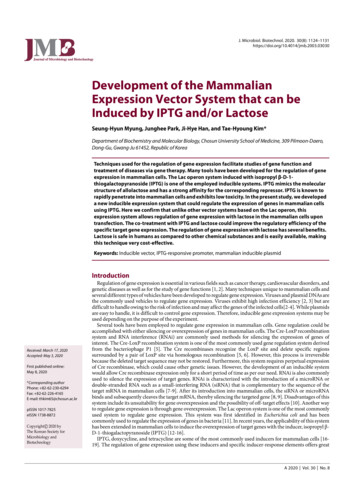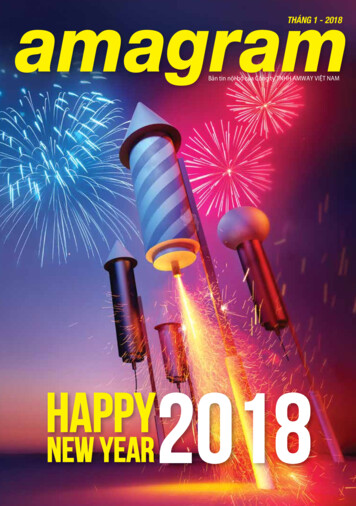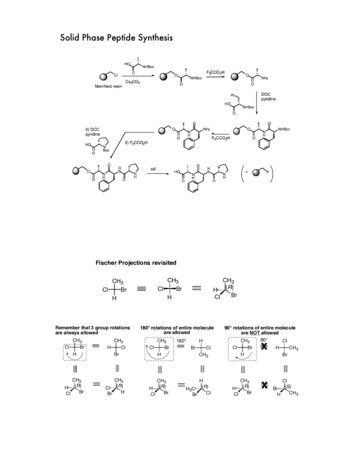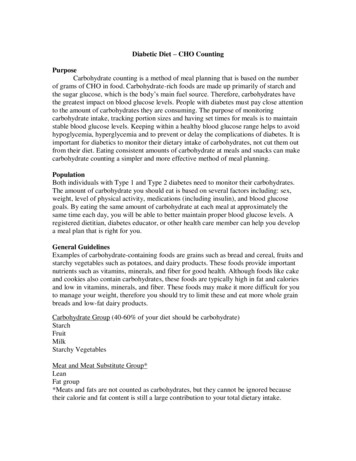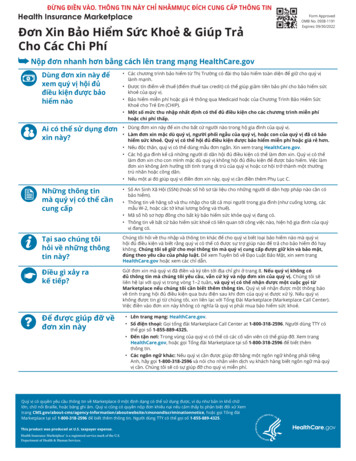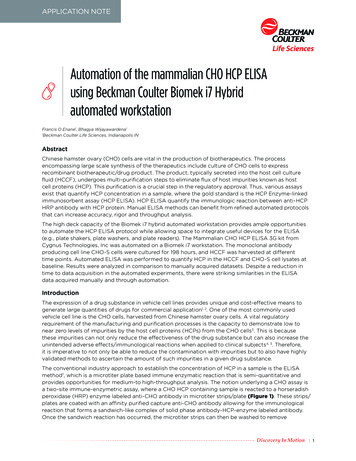
Transcription
APPLICATION NOTEAutomation of the mammalian CHO HCP ELISAusing Beckman Coulter Biomek i7 Hybridautomated workstationFrancis O Enane1, Bhagya Wijayawardena11Beckman Coulter Life Sciences, Indianapolis INAbstractChinese hamster ovary (CHO) cells are vital in the production of biotherapeutics. The processencompassing large scale synthesis of the therapeutics include culture of CHO cells to expressrecombinant biotherapeutic/drug product. The product, typically secreted into the host cell culturefluid (HCCF), undergoes multi-purification steps to eliminate flux of host impurities known as hostcell proteins (HCP). This purification is a crucial step in the regulatory approval. Thus, various assaysexist that quantify HCP concentration in a sample, where the gold standard is the HCP Enzyme-linkedimmunosorbent assay (HCP ELISA). HCP ELISA quantify the immunologic reaction between anti-HCPHRP antibody with HCP protein. Manual ELISA methods can benefit from refined automated protocolsthat can increase accuracy, rigor and throughput analysis.The high deck capacity of the Biomek i7 hybrid automated workstation provides ample opportunitiesto automate the HCP ELISA protocol while allowing space to integrate useful devices for the ELISA(e.g., plate shakers, plate washers, and plate readers). The Mammalian CHO HCP ELISA 3G kit fromCygnus Technologies, Inc was automated on a Biomek i7 workstation. The monoclonal antibodyproducing cell line CHO-S cells were cultured for 198 hours, and HCCF was harvested at differenttime points. Automated ELISA was performed to quantify HCP in the HCCF and CHO-S cell lysates atbaseline. Results were analyzed in comparison to manually acquired datasets. Despite a reduction intime to data acquisition in the automated experiments, there were striking similarities in the ELISAdata acquired manually and through automation.IntroductionThe expression of a drug substance in vehicle cell lines provides unique and cost-effective means togenerate large quantities of drugs for commercial application1, 2. One of the most commonly usedvehicle cell line is the CHO cells, harvested from Chinese hamster ovary cells. A vital regulatoryrequirement of the manufacturing and purification processes is the capacity to demonstrate low tonear zero levels of impurities by the host cell proteins (HCPs) from the CHO cells3. This is becausethese impurities can not only reduce the effectiveness of the drug substance but can also increase theunintended adverse effects/immunological reactions when applied to clinical subjects4, 3. Therefore,it is imperative to not only be able to reduce the contamination with impurities but to also have highlyvalidated methods to ascertain the amount of such impurities in a given drug substance.The conventional industry approach to establish the concentration of HCP in a sample is the ELISAmethod1, which is a microtiter plate based immune enzymatic reaction that is semi-quantitative andprovides opportunities for medium-to high-throughput analysis. The notion underlying a CHO assay isa two-site immune-enzymetric assay, where a CHO HCP containing sample is reacted to a horseradishperoxidase (HRP) enzyme labeled anti-CHO antibody in microtiter strips/plate (Figure 1). These strips/plates are coated with an affinity purified capture anti-CHO antibody allowing for the immunologicalreaction that forms a sandwich-like complex of solid phase antibody-HCP-enzyme labeled antibody.Once the sandwich reaction has occurred, the microtiter strips can then be washed to removeDiscovery In Motion 1
non-specifically bound or any unbound reactants. This is then followed by the addition of a substrate,tetramethylbenzidine (TMB), which hydrolyzes with the antibody-HCP-enzyme sandwich, where theamount of hydrolyzed substrate is proportional to the concentration of CHO HCP present in thesample5. The hydrolyzed product can thus be quantified using a microtiter plate to determine theunknown concentration of CHO HCPs present in a sample.While ELISA methods can be highly sensitive and specific, their accuracy and reproducibility aredependent on the analyst experience and expertise 6. Moreover, the multi-stage liquid transfer stepscan also introduce pipetting errors that could yield differential data across large data sets. Developingautomated CHO HCP ELISA procedures can eliminate the human error rate associated with ELISAprotocols producing time efficient and highly reproducible results in a hands-free environment.The Beckman Coulter Biomek i7 hybrid liquid handling system (Figure 2) is uniquely suited for suchautomation, as it contains a large deck with ample space for direct integration of devices useful for theELISA (e.g., plate shakers, plate washers, and plate readers). We performed an automated CHO-HCPELISA on the Biomek i7 liquid handler using the mammalian ELISA 3G kit from Cygnus technologiesInc. Our results were highly reproducible and comparable to those acquired through manualexperimentation and suggested a reduction in the total protocol time needed forfinal data acquisition.Figure 1. CHO HCP ELISA WorkflowDiscovery In Motion 2
MethodsELISAThe ELISA manual experiments were performed following the recommended protocol of themammalian CHO HCP ELISA 3G kit from Cygnus Technologies, Inc (Cat #F550-1). The kit wasmanually validated using the standards provided to generate a standard curve (Figure 3A). Additionalvalidation was performed using a secondary standard, designed by spiking varying concentrations(0 – 1000 ng/mL) of the mammalian CHO HCP protein concentrate (Cygnus Cat# no. F553H) spikedinto deionized water (diH2O). All experiments were performed in triplicates. The concentration of proteinfrom unknown samples was determined using the standard curve slope intercept equation.Key equipment, reagents and resources used are listed in the material section. For automation, manualELISA protocol was converted into Biomek methods using Biomek software.Biomek methodsThe automated experiments were performed by converting the liquid movement and transfer stepsof the protocol (Figure 1) as recommended in the kit into Biomek methods using the Biomek i5 software(Figure 2-right panel). Minor adjustments and modifications were added to enhance the automatedexperiments. Biomek i7 instruments have a high-density deck that can accommodate enough labwareto use fresh tips for each transfer (Figure 2-bottom panel) yet retain the flexibility to integrate devicesuseful for the ELISA such as shakers, plate washers, and plate readers. The current experiments wereperformed on a Biomek i7 containing an integrated orbital plate shaker and a SpectraMax i3x platereader (Molecular Devices). Shaking and incubations were performed using an on-deck orbital shaker.The Biomek i5 software provides efficient ability to control liquid movement and transfer making, itpossible to accommodate removal of all samples, reagents, and washes from the wells in the absence ofa plate washer. Aspiration of the large volume (340 µL) of the wash buffer was followed by small volume(5 µL) aspirations on edge of the plate to ensure complete removal of media and automate thestep in the manual protocol that requires inversion of the plate on absorbent pads.CHO-S cell cultureCHO-S Cells (cGMP Banked) were ordered from Fisher Scientific (cat. No. A11557-01) and were culturedin CD CHO Medium (Fisher Scientific, Cat No. 10743-029) supplemented with 8mM L-Glutamine (FisherScientific, Cat. No A2916801). The cells were Incubated at 37 C in a humidified atmosphere of 5% CO2(VWR Scientific Products) in air on an orbital shaker (Orbi-shaker, Benchmark Scientific) platformrotating at 125 rpm. The culture flask caps were Loosened to allow for gas exchange. Cell confluencywas measure at 48, 120, and 198 hours using Beckman Coulter Vi-CELL automated cell viability analyzer.Both HCCF and cell pellets were collected by centrifugation on an Allegra X-15R centrifuge (BeckmanCoulter) and the protein was isolated from cell pellets using the mammalian M-PER protein extractionreagent from Thermo Scientific (Cat. No 78501).Discovery In Motion 3
Figure 2. Automation on Biomek i7 hybrid automated liquid handler. Interaction between the workstation and the user is achievedusing the Biomek methods written using Biomek i5 software.ResultsStandard curve analysis and kit validationThe kit was validated by two approaches using manual experimentation. First, we generated astandard curve using the standards provided in the kit (Figure 3A). We then generated secondarystandards by spiking diH2O with incremental concentrations of CHO HCP concentrate (Figure 3B).The standard curves from both experiments had similar results that were consistent with manufacturerrecommendations (Figure 3A-B). The standards provided in the kit have concentrations of0 ng/mL, 1 ng/mL, 3 ng/mL 12 ng/mL, 40 ng/mL and 100 ng/mL. We thus evaluated any detectionthreshold by designing new standards using spiked HCP concentrate protein that were 0 ng/mL,0.1 ng/mL, 0.3 ng/mL, 1 ng/mL, 3 ng/mL 12 ng/mL, 40 ng/mL, 100 ng/mL and 1000 ng/mL in thespiked experiments. As expected, there was consistent incremental absorbance from the low to highconcentration (Figure 3C) and no differences were observed when comparing the absorbanceobtained from the kit standards and that of the spiked standards (Figure 3D). The total manualexperimental time including the 2-hour 30 minutes incubation steps was 3 hours and 10 minutes foran 18-sample experiment.Discovery In Motion 4
Figure 3. Manual standard curve analysis and kit validation A) Standard curve from kit standards B) Standard curve using spikedsamples C) Absorbance versus spiked HCP concentrations (ng/mL). D) Comparison of absorbance from kit standardsversus spiked standards. All experiments performed in triplicate and manually.To automate the kit, we first performed the standard curve experiment on the Biomek i7 to determineconsistency of the automated liquid transfer steps using the Span-8. There were consistent similaritiesbetween the manual standard curve (R 2, 0.9891), and the standard curve from data generatedusing Biomek (R 2, 0.9932) (Figure 3A, 5A). The total estimated time for an 18-sample automatedexperimental was 2 hours 47 minutes including the 2-hour 30 minutes incubation steps. Compared tothe manual run there was an estimated reduction in the automated experimental time by 23 minutes.Figure 4. CHO-S Cell culture and viability. A) CHO-S cell proliferation over time. The number of cells (viable versus dead) at specificsample harvesting time points B) Percent viable cells in samples collected for time points analysis.We thus designed a low-to medium-throughput experiment to measure the concentration of HCPin HCCF of cultured CHO-S cells and in protein lysates of CHO-S at baseline. Here CHO-S cells werecultured for 198 hours, and HCCF and cell pellets were collected at 48, 120, and 198-hour time points intriplicates. We determined that cell proliferation was consistent with previous reports [1] (Figure 4A)and that cells were healthy and viable ( 85% cell viability) at each sample collection point (Figure 4B).We collected HCCF and cell pellets using centrifugation and the sorted cell pellets were used to isolateCHO-S protein. Automated experiments were then performed on the Biomek i7 using the kit standardsand unknown samples of HCCF and CHO-S protein lysate at 48, 120, 198-hours.Discovery In Motion 5
The total number of samples analyzed including standards, negative control (diH2O), positive control(200ng CHO HCP concentrate), and HCCF and CHO-S protein lysates at specified time points was 42samples, or approximately half of a 96 well plate assay. We observed high linearity in the standard curve(R 2, 0.9932, Figure 5A). Using extrapolation and slope intercept equation, the HCP concentration inthe unknown samples was calculated (Figure 5B). As expected, the negative control contained low toundetectable levels of CHO HCP (Figure 5B). While 200 ng of CHO HCP concentrate was spiked intodiH2O and used as positive control, the calculated values of HCP measured approximately 200 ng in thepositive control samples (Figure 5B).Figure 5. Automated CHO HCP ELISA to measure unknown CHO protein in CHO-S samples. A) CHO HCP standard curve resultsgenerated on Biomek i7 work station B) Quantification of CHO protein in CHO-S HCCF and protein from CHO-S cell lysate generatedon the Biomek i7 workstation.Our analysis suggested detectable levels of CHO HCP protein in both the CHO HCCF fluid andCHO protein lysates at all time points analyzed (Figure 5B). However, we noted minimal variabilityin the amount of HCP protein at different time points. We speculate that this could be due to theuse of healthy cells with low death rate and once that were at an early passage (P1-P3) without anytransfected recombinant protein (Figure 4A). Moreover, the kit lower limit detection (LOD) defined asthe concentration corresponding to a signal two standard deviations above zero standard is 0.3 ng/mL. The lower limit of quantitation (LOQ), defined as the first dosed standard is 1 ng/mL. While thereis no detection limit established as acceptable for HCP levels, 100 ng is considered for setting HCPspecifications7,8 . The estimated time to completion of the experiment was 2-hours, 59 minutes, 39seconds for a 42-sample assay plate including the 2.5-hour incubation times needed in the protocol.Importantly, we evaluated similarities in the data acquired manually or though the Biomek automationprotocol by comparing the absorbance from manual versus automated results. The datapoints werestrikingly similar at all concentrations (Figure 6), suggesting that automation of the protocol did notinterfere with the experimental procedure, reagent stability and data acquisition.Figure 6. Manual versus Automated standard curve absorbance data. The standard curve data was strikingly similar when data wasgenerated manually (red) or by automation (green)Discovery In Motion 6
SummaryThe current automated method successfully demonstrated the automation of the mammalian CHOHCP ELISA assay using the Beckman Coulter Biomek i7 liquid handler. We demonstrated the 42-assayplate sample analysis containing triplicate standard curve samples, triplicate negative control, triplicatepositive control, and 6 unknowns analyzed in triplicate for a total of 18 unknown samples.Total estimated time on the Biomek was approximately 3 hours with two incubation steps totaling2 hours and 30 minutes. In a comparative 18 sample run between manual experiments and automatedexperiments, there was a decrease in assay time by 23 minutes. This suggests that automationcould maintain not just the accuracy and reproducibility of the assay but can also lower time to dataacquisition and analysis. The current method was performed using Span-8, however in high-throughputassays, the Biomek methods can be revised to use the multichannel head capable of transferring upto 1mL of liquid in a single transfer. This can be useful in the wash step that requires a bulk transferof 300 µL volume per lane to accelerate the 4x wash steps by using the multi-dispense function.Labware integrations (e.g., plate shakers, plate washers, and plate readers) can contribute to throughputefficiency by decreasing interactions with the system to eradicate human error rate and increasewalk-away time for the analyst. Moreover, the Biomek data acquisition and reporting tool (DART) is asoftware package designed to gather data and synthesize runtime information from Biomek log filescapturing each manipulation of the sample during the Biomek method development. This eliminatestime-consuming and error-prone “cut-and-paste” style management of sample data. DART seamlesslyorganizes data from Biomek liquid handlers, integrated lab equipment and benchtop devices into asingle data source. Importantly, this automated method demonstrated that HCP ELISA automationcannot only produce highly reliable results from throughput analysis but can also decrease the protocolrun time and increase analyst walk-away time.References1.Lesley M Chiverton et al, “Quantitative definition and monitoring of the host cell protein proteome using iTRAQ- a study of an industrial mAb producing CHO-S cell line,” Biotechnology Journal, vol. 11, no. 8, pp. 1014-1024,2016.2.K. N. Valente, N. E. Levy, K. H. Lee, K. H. Lee and A. M. Lenhoff, “Applications of proteomic methods for CHOhost cell protein characterization in biopharmaceutical manufacturing,” Current Opinion in Biotechnology, vol.53, no. , pp. 144-150, 2018.3.H. S. Marzieh, T. . Bahman, H. . Shahin, Y. . Fereshteh, K. . Razieh, S. . Mohammad, N. . Mahdi and V. . Javad,“Increased the specificity and sensitivity of monospecific antibody against host cell protein (HCP) in qualitycontrol of hepatitis B recombinant vaccine,” Journal of paramedical sciences, vol. 2, no. 3, pp. 24-29, 2011.4.G. . Walsh, “Biopharmaceutical benchmarks 2014,” Nature Biotechnology, vol. 32, no. 10, pp. 992-1000, 2014.5.T. L. Martin, E. J. Mufson and M.-M. . Mesulam, “The light side of horseradish peroxidase histochemistry.,” Journalof Histochemistry and Cytochemistry, vol. 32, no. 7, pp. 793-793, 1984.6.G. . Rey and M. W. Wendeler, “Full automation and validation of a flexible ELISA platform for host cell proteinand protein A impurity detection in biopharmaceuticals.,” Journal of Pharmaceutical and Biomedical Analysis,vol. 70, no. , pp. 580-586, 2012.7.W. R. M. H. S. Z. M. B. a. J. R. W. Haiyan Liu, “HCP Antigens and Antibodies from Different CHO Cell Lines,”Bioprocess international, 2017.8.R. F. C. M. S. Daniel G. Bracewell, “The future of host cell protein (HCP) identification during processdevelopment and manufacturing linked to a risk-based management for their control,” Biotechnology andBioengineering, vol. 112, p. 1727–1737, 2015.Discovery In Motion 7
MaterialsEquipmentManufacturerBiomek i7 hybrid automated liquid handlerBeckman coulter Life SciencesSpectramax i3x plate readerMolecular Devices, INCOrbital shakerBenchmark Scientific, INCOrbi-shakerBenchmark Scientific, INC37ºC cell culture incubator 7VWR Scientific ProductsAllegra X-15R centrifugeBeckman Coulter Life SciencesReagentsCHO HCP ELISA 3G kitMammalian CHO HCP protein concentrateManufacturerCygnus Technologies, INCCHO STM cells (cGMP banked)CD CHOO MediumFisher Scientific, INCBC1070 Pipette TipsF553H10743-02978501ManufacturerPart NumberBeckman Coulter Life SciencesB85906BC90 Pipette TipsBC230 Pipette TipsF550-1A11557-01mammalian M-PER protein extraction reagentReagentsPart NumberB85884B85945Biomek Automated Workstations are not intended or validated for use in the diagnosis of disease or other conditions. 2020 Beckman Coulter, Inc. All rights reserved. Beckman Coulter, the Stylized Logo, and Beckman Coulter productand service marks mentioned herein are trademarks or registered trademarks of Beckman Coulter, Inc. in the UnitedStates and other countries. All other trademarks are the property of their respective owners. SpectraMax is a trademarkof Molecular Devices; CHO-S, CHO S Medium, and mammalian M-PER protein extraction reagent are trademark ofThermo Fisher Scientific; and Orbi-Shaker is a trademark of Benchmark Scientific; CHO HCP ELISA 3G kit is trademarkfor Cygnus Technologies.This protocol is for demonstration only and is not validated by Beckman Coulter. Beckman Coulter makes no warrantiesof any kind whatsoever express or implied, with respect to this protocol, including but not limited to warranties offitness for a particular purpose or merchantability or that the protocol is non-infringing. All warranties are expresslydisclaimed. Your use of the method is solely at your own risk, without recourse to Beckman Coulter. Not intended orvalidated for use in the diagnosis of disease or other conditions.For Beckman Coulter’s worldwide office locations and phone numbers, please visit Contact Us at beckman.comAAG-8075APP10.20
useful for the ELISA such as shakers, plate washers, and plate readers. The current experiments were performed on a Biomek i7 containing an integrated orbital plate shaker and a SpectraMax i3x plate reader (Molecular Devices). Shaking and incubations were performed using an on-deck orbital shaker.


